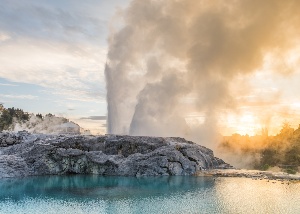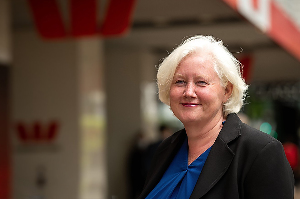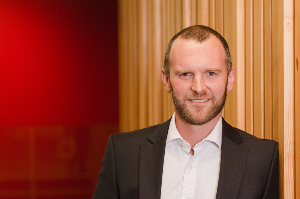
Rotorua has its sights set on becoming a billion dollar tourism industry in the near future, and a $27.4 million contribution from the Government’s Provincial Growth Fund is fast tracking that goal.
The funding will be put to good use in the $55 million development of the city’s two “Big Moves” projects – the redevelopment of Rotorua's lakefront and Whakarewarewa Forest.
Work for both projects is expected to commence this year and will include new boardwalks, parking, children's play areas, a wharewaka, terraces, cafes and restaurants; while there will be a new visitor centre built at Whakarewarewa Forest.
Alongside these plans, private investment in Rotorua is growing at pace. A $30 million luxury spa and wellness centre on the waterfront called Wai Ariki is being developed by Pukeroa Oruawhata Group.
It is expected to employ 80 staff and be completed in late-2021.
Employment is strong in the tourism and hospitality-led city, yet the infrastructure needed to support the accommodation of the burgeoning number of tourist visitors and increasing local population has stalled.
There are small pocket developments happening around the city, but a recent Special Housing Area (SHA) at Ngongotaha was declined by the Minister for Housing and Urban Development in August due to potential flooding risks.
It’s been a frustrating exercise for Mayor Steve Chadwick, who following the announcement said the lack of housing supply was reaching critical levels.
“It is extremely frustrating the application has been declined. The people of Rotorua are being denied housing at a time when they need it the most,” Mayor Chadwick said.
“We have the second highest rate of registered homelessness in the country and we are bitterly disappointed the Minister declined this application.”
The lack of support for residential development mean unsurprising supply issues have arisen.
The burgeoning tourism industry is a key driver for the lack of housing supply says Harcourts’ Trevor Cochrane, particularly given the impact of short-term holiday rentals on the rental market.
“Because of all of the houses on Bookabach.co.nz, it’s taken a lot of rentals out of the market. I think there’s about 800 houses on Bookabach – we are finding some investors now are buying flats and renting them out [short term].”
It’s a problem other tourism destinations – such as Queenstown – face. However, unlike Queenstown its prices are far more accessible to investors – the median sale price sits at $445,000 (in Queenstown it’s more than double that).
Short-term accommodation market minder AirDNA shows 1,141 active short-term rentals across Airbnb and HomeAway sites (of those 879 are entire homes), with an average daily rate of $128 [at time of print].
The council has a 100-day threshold before landlords of holiday accommodation are required to pay additional rates, and the system is self-policing.
Locals say it’s created an uneven playing field for hotel owners versus landlords and it’s led to rent increases due to the number of short-term rentals taken off the long-term rental market.
Yet Rotorua is still short on accommodation for tourists (despite the two hotels currently being built) and there’s an undersupply of houses for sale, which doesn’t look likely to ease any time soon.
Cochrane says there is currently under 200 houses for sale in Rotorua, “which, if you want to compare that to January in 2015, we had 779”.
“The median sale price has gone up an average of 12% in Rotorua, and in the last five years, probably 80%. I’ve had lots of people ringing me and emailing me looking for blocks of flats that they want to buy. You don’t often get that.”
However, he says one advantage of Rotorua property is the commonly available quarter acre sub-dividable section.
It’s a great niche opportunity for investors, even if they only add a second dwelling to bring the yield up, “you don’t have to subdivide, because that’s at least [a cost of] $50,000”.
Finding the deals
Because sales supply is tight, investors need to search harder and longer to get yields above 6%, and perhaps lower their expectations to meet the market, says iFindProperty agent Debbie Van Den Broek.
“Before I could find one or two a week, now if I find one or two a month I’m doing very well. It just takes a lot more looking – investors need to be very careful how they purchase.”
Auckland investor Chris Davis recently secured a double-income duplex property of two, two-bedroom units in central Rotorua through Van Den Broek – it was his first investment property outside Auckland.
Davis, who spent a lot of time wakeboarding in Rotorua when he was younger, says investing in the tourist hot spot was a no-brainer.
“Nowhere else has epic lakes, the geysers and the restaurants and everything right there – Rotorua’s got the gondola, the luge, mountain-biking, you’ve got that epic trout farm – there’s just so much to do.”
His duplex was purchased for $495,000 and has a 6.97% yield and he’s happy with both sets of tenants, who he kept in situ after taking ownership.
For a regional investment the location is incredibly accessible, says Davis.
“You’re close to the mountain and to Tauranga … And you’re only three and half hours to Auckland – I can easily pop down there for the weekend for a reno job.”
Beware of high rents
When it comes to rental supply, Rotorua Rentals property manager Maree Passier says “we’re still using the word ‘crisis’ – because it definitely is”.
Tenants are coming to realise this and there is little movement in tenancies. Additionally, fixed-term contracts are becoming common, as tenants seek security of tenure, she says.
“They are fixing terms way more than they ever used to and we’re encouraging it for both parties,” says Passier.
Rents across Rotorua have increased around 10% in the past year and 50% over the past five years but this appears to be levelling off, in line with landlords completing upgrades to their homes to meet the new healthy homes standards.
“I think a lot of the older stock was behind the eight-ball – that stuff has now caught up with the rents.”
But Van Den Broek says while rents have increased, investors should be wary of rents that seem inflated.
“We’re finding that the rents are really high and they’ve gone up considerably in the last three months. You could probably rent a house for whatever you ask, but you start compromising your quality of tenants, because it appears WINZ will pay anything to get people into homes – it’s cheaper than having them in a hotel.”
There’s always good deals to be had, she says, but “you’ve just got to watch that rent isn’t artificially inflated and that tenant quality isn’t compromised”.
Hot suburbs
Rotorua has been known to have some lower socio-economic areas, but EVES agent Joy Kelly says there are plenty of investors who are “savvy and know what they’re doing and are more than comfortable to invest in those areas”.
For newer investors, she recommends moving up the price scale if possible.
“We have some really good value properties through Mangakakahi, Puketangi and Western Heights that are ideal rental properties showing reasonable returns – those are good, middle-of-the-road areas.”
But Van Den Broek says Western Heights properties don’t always represent good value and moving up slightly in the market can pay dividends.
“That next level property is getting priced to be close to the very average grade rental. That’s probably where to look. You can get some better quality [rentals] and attract better tenants in Fairy Springs and Kawaha Point, for not much of a price differential.”
Cochrane says for capital gains he recommends Lynmore, Springfield and Pukehangi, “but if you wanted returns you’re probably going to look at Western Heights, Selwyn Heights, Fordlands, Mangakakahi”.
Another location only 65km from Rotorua that’s worth a look is Murupara, says Cochrane.
“Last year the average price went up 43% and there’s a possibility of a water-bottling plant going in there. If it does, it’s going to employ about 500 people. We haven’t got enough accommodation for the people who live out there now.”
Looking ahead
The demand for rental property looks likely to stay high over the next year across all suburbs, agree all the industry experts.
“It’s almost a perfect storm at the moment, but if not, it’s on its way,” says Kelly. She cites the spring uptick in supply, balanced against the growing number of first home buyers coming on to the market.
As such, despite the recent boom times levelling off, she doesn’t predict a downturn – “we could even be in for more price increases. I see good times ahead.”




Comments
No comments yet.
Sign In to add your comment